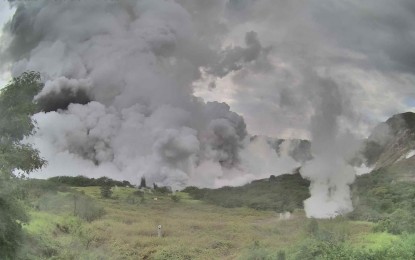
TAAL VOLCANO. Ongoing phreatic explosion at the main crater of Taal Volcano since Sunday afternoon (Jan. 12, 2020). Taal Volcano is still on Alert Level 4. (Photo grabbed from Phivolcs Twitter account)
MANILA -- Since the Taal Volcano's eruption on Sunday, the public has been dealing with ashfall -- how to clean it, and how to protect themselves against it.
According to cardiologist Willie Ong, both the ashfall and lava haze are harmful to one's health. Breathing these may damage the lungs, or may cause difficulty in breathing.
Prolonged exposure may even lead to other illnesses, such as asthma, bronchitis, stroke, and even heart attack, he said on his Facebook page.
With this, the doctor, through his YouTube channel, gave the public some tips on what they could do against the ashfall like the wearing of face mask.
Ong said one should ensure the mask is fit or sealed when worn. It may also be helpful to wear double masks, he added.
For those who have a budget, Ong said wearing an N95 mask is better, as this is the one being worn during epidemic, or against tuberculosis and SARS.
He also advised that doors, windows are closed as well as sprinkling some water before wiping off the ash so that it would not go up.
Ong added not to put the ash in the sewerage system and this must be placed in a plastic or drum, he said.
For those living near Taal Lake, he said it best to wash the food and vegetables thoroughly.
Use of air-conditioner, he said, is okay since this has a filter. He warned, however, that the filter may not function if the pollution is too heavy.
Meanwhile, kids, elderly, pregnant women, and those with illnesses should avoid going out of their house if necessary, consult a doctor if they experience difficulty in breathing.
Taal Volcano has been on Alert Level 4 since Sunday afternoon. Since then, the Department of Health has been urging the public to take precautions, due to the health effects of exposure to volcanic ash and gases.
The Philippine Institute of Volcanology and Seismology (Phivolcs) already recommended total evacuation of Taal Volcano Island, high-risk areas within the 14-kilometer radius from Taal, and along the Pansipit River Valley.
Phivolcs uses the alert level to forecast the condition of the volcano.
Since March 2019, Phivolcs has been raising the Alert Level status in Taal from zero to one. Zero level means the volcano is quiet, while Level 1 means there is disturbance in magma, earth surface, and hydrothermal activities.
Due to the fast escalation of volcanic activity in Taal on Sunday afternoon, Phivolcs raised the Alert Level to 2 (increasing unrest), which means there's a low to moderate level of seismicity, persistence of local but unfelt earthquakes.
Alert level 3 was also raised only about two hours after the volcano was put on Alert Level 2 status. Alert level 3 means there's a relatively high magmatic unrest, sudden or increasing changes in temperature, and bubbling activity.
Alert Level 4 was raised by 7:30 p.m. Sunday, referring to the possibility of hazardous explosive eruption within hours to days. (PNA)
